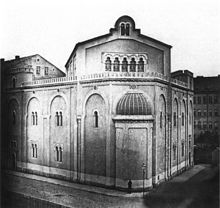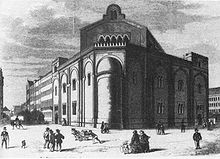Great community synagogue

The Great Community Synagogue (also called Der Tempel or later Old Synagogue ) in Leipzig was the oldest and most important synagogue in the city. It was built between 1854 and 1855 according to plans by Semper's student Otto Simonson . The foundation stone was laid on September 9, 1854. On September 10, 1855, the new synagogue was handed over to its intended use by Rabbi Adolf Jellinek . During the November pogroms , the church was set on fire and destroyed on the night of November 9-10, 1938. From November 11, 1938 to February 12, 1939, the ruins were torn down at the expense of the Israelite religious community. The synagogue stood immediately to the west of the promenade ring on the corner plot of Gottschedstrasse 3 / Zentralstrasse.
architecture
Layout
The synagogue had the plan of a dragon square . The main nave was separated from the aisles by two rows, each with four columns, with the aisles being cut off at an angle due to the floor plan. In the west there was a tower in the central axis of the main nave. Between the outer walls of the side aisles and the outer boundary walls there were gusset rooms in which towers with stairwells were built. These towers gave access to the women's gallery . A lower structure with entrance, vestibule, cloakrooms, courtyard and a small weekday synagogue was connected to the west tower on the central axis of the main wing .
Exterior architecture
Only the eastern tip of the dragon square at the confluence of the road could be seen from the ground plan. In front of the chamfered edge of the building, Simonson placed the semicircular apse , the Torah shrine , to which the front sides of the synagogue fan-like connected to both streets at the same height. So the eastern point on the street corner became the actual main view of the building. The two street facades, which met at an acute angle in the street corner, were divided into four axes by Simonson . Each of these axes, fitted with twin windows on the lower and upper floors, was adorned by a blind arch in the shape of a horseshoe .
The top floor of the rectangular three-storey main nave towered over the two-storey building in the shape of a tapering triangle. Its gabled narrow side, which just came into effect in the main view of the building across the corner, was given a five-part arcade frieze and the two tablets of the law as the top of the gable.
Interior design
The sacred building was built as a gallery basilica for 1,600 visitors, using Indo-Islamic architecture .
Two rows, each with four columns, separated the three-story nave from the two-story aisles with women's galleries. The two rows, each with four columns, formed "rectangular openings, the gussets of which were filled with small lobed arches" on the first floor as the upper end and large horseshoe arches as the upper end on the second floor. Above the horseshoe arches, towards the side aisles with the women's galleries, there were three-part, also horseshoe-shaped windows as upper cladding, which were framed by a high rectangular panel.
The coffered ceiling was symmetrically divided into three longitudinal zones, with small stalactites hanging down at the interfaces between the transverse and longitudinal beams . Rosettes, interconnected squares and loops formed a pattern that was reminiscent of Spanish-Islamic architecture.
The east side was adorned with an ensemble of pulpit on the northeast corner , bima and Torah shrine. The pulpit of the synagogue was comparable to a pulpit from a Christian sacred building, with the stalactite-decorated substructure of the pulpit and the dome crowning reminiscent of Islamic mosque pulpits or minbars . The bima was behind a grille. The lectern stood in front of another, raised latticework. To this tall latticework there were stairs on either side. The wall of the Torah shrine was divided symmetrically into three parts with a wide central part and narrower side parts.
organ
In 1868 or 1856, the synagogue received a two-manual organ with 20 registers on mechanically operated sliding chests , built by the Weißenfels organ builder Friedrich Ladegast . The organ was destroyed together with the synagogue in 1938.
Disposition
|
|
|
|||||||||||||||||||||||||||||||||||||||||||||||
-
Pairing :
- Manual coupling
- Pedal coupler
Technical specifications
- Number of pipes:
- Main work - 684
- Upper work - 270
- Pedal - 135
- Casing:
- in the Moorish style
- Wind supply:
- 3 box bellows
present
On November 18, 1966, a small memorial stone made of Cotta sandstone by the Leipzig sculptor Hans-Joachim Förster (* 1929) was inaugurated in memory of the Jewish community and the destruction of their church on the former north facade .
The site of the former synagogue had served as a parking lot and a transformer station for decades. After the city of Leipzig only became the owner of the property in 1997, in 1999, in collaboration with the Israelite Religious Community, it launched an anonymous competition open to Saxony-wide, to which ten international artists were invited. Ultimately, the decision was made in favor of the design by the Leipzig-based Sebastian Helm (* 1969) and Anna Dilengite (* 1970), who had only made it into the shortlist for realization in the competition.
After a majority decision by the Leipzig City Council in October 2000, the property was converted into a large-scale memorial. The mark, inaugurated on June 24, 2001, traces the floor plan of the destroyed building over an area of 12 × 12 meters. The interior forms a field of 140 empty bronze chairs, which are intended to make the loss of the architectural shell tangible. The western boundary of the property forms a wall made of exposed concrete with texts in English, German and Hebrew on three bronze panels each.
See also
literature
- Heinrich Magirius , Hanna-Lore Fiedler: The architectural and art monuments of Saxony. City of Leipzig. The sacred buildings. Deutscher Kunstverlag, Munich 1995, Volume 1, pp. 791-803, ISBN 3-422-00568-4 .
- Markus Cottin et al .: Leipzig monuments. Edited by the Leipziger Geschichtsverein e. V., Sax-Verlag, Beucha 1998, p. 118, ISBN 3-930076-71-3 .
- Markus Cottin et al .: Leipzig monuments. Volume 2. Edited by the Leipziger Geschichtsverein e. V., Sax-Verlag, Beucha 2009, pp. 87 f., ISBN 978-3-86729-036-4 .
- Bernd-Lutz Lange : Jewish traces in Leipzig. A companion through the city. Forum Verlag, Leipzig 1993, ISBN 3-86151-049-9 .
- Hannelore Künzl: Islamic style elements in synagogue construction of the 19th and early 20th centuries (Judaism and the Environment, Volume 9). Publishing house Peter Lang, Frankfurt am Main u. a. 1984, ISBN 3-8204-8034-X . On the Leipzig synagogue: p. 188 ff.
- Fritz Oehme: Handbook about older, newer and newest organ works in the Kingdom of Saxony. Photomechanical reprint of the original Dresden edition 1889–1897. Edited with supplement and registers by Wolfram Hackel with the collaboration of Ulrich Dähnert. Edition Peters, Leipzig 1978, Volume II, p. 102 f., Supplement, p. 143.
- Klaus Arlt, Constantin Beyer: Evidence of Jewish Culture . Memorial sites in Mecklenburg-Western Pomerania, Brandenburg, Berlin, Saxony-Anhalt, Saxony and Thuringia. Tourist-Verlag, Berlin 1992, ISBN 3-350-00780-5 .
- The new synagogue in Leipzig . In: The Gazebo . Issue 40, 1854, pp. 476–478 ( full text [ Wikisource ]).
Web links
- Synagogue monument. University of Graphics and Book Art Leipzig
- 3D model: virtual reconstruction of the historic Leipzig synagogue (and other former German synagogue buildings), TU Darmstadt
Individual evidence
- ↑ a b Magirius; Fiedler, Volume 1, p. 791
- ^ Arlt, Beyer: Evidence of Jewish Culture. ... p. 240.
- ↑ a b Künzl, p. 188
- ↑ a b c Künzl, p. 189
- ↑ Künzl, p. 190
- ↑ a b Künzl, p. 193
- ↑ Künzl, p. 194
- ↑ Künzl, p. 195
- ↑ a b Oehme, Supplement, p. 143
- ^ J. Massmann: The organ works of the residence city of Schwerin. Wismar 1875
- ↑ a b Oehme, Volume II, p. 102 f.
Coordinates: 51 ° 20 ′ 23.6 " N , 12 ° 22 ′ 10.8" E






